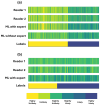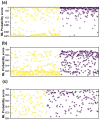Between Two Worlds: Investigating the Intersection of Human Expertise and Machine Learning in the Case of Coronary Artery Disease Diagnosis
- PMID: 39451333
- PMCID: PMC11504143
- DOI: 10.3390/bioengineering11100957
Between Two Worlds: Investigating the Intersection of Human Expertise and Machine Learning in the Case of Coronary Artery Disease Diagnosis
Abstract
Coronary artery disease (CAD) presents a significant global health burden, with early and accurate diagnostics crucial for effective management and treatment strategies. This study evaluates the efficacy of human evaluators compared to a Random Forest (RF) machine learning model in predicting CAD risk. It investigates the impact of incorporating human clinical judgments into the RF model's predictive capabilities. We recruited 606 patients from the Department of Nuclear Medicine at the University Hospital of Patras, Greece, from 16 February 2018 to 28 February 2022. Clinical data inputs included age, sex, comprehensive cardiovascular history (including prior myocardial infarction and revascularisation), CAD predisposing factors (such as hypertension, dyslipidemia, smoking, diabetes, and peripheral arteriopathy), baseline ECG abnormalities, and symptomatic descriptions ranging from asymptomatic states to angina-like symptoms and dyspnea on exertion. The diagnostic accuracies of human evaluators and the RF model (when trained with datasets inclusive of human judges' assessments) were comparable at 79% and 80.17%, respectively. However, the performance of the RF model notably declined to 73.76% when human clinical judgments were excluded from its training dataset. These results highlight a potential synergistic relationship between human expertise and advanced algorithmic predictions, suggesting a hybrid approach as a promising direction for enhancing CAD diagnostics.
Keywords: coronary artery disease; machine learning; probability calibration; random forest.
Conflict of interest statement
The authors declare no conflict of interest.
Figures




Similar articles
-
Pre-test probability for coronary artery disease in patients with chest pain based on machine learning techniques.Int J Cardiol. 2023 Aug 15;385:85-93. doi: 10.1016/j.ijcard.2023.05.041. Epub 2023 May 23. Int J Cardiol. 2023. PMID: 37230426
-
Enhanced External Counterpulsation (EECP): An Evidence-Based Analysis.Ont Health Technol Assess Ser. 2006;6(5):1-70. Epub 2006 Mar 1. Ont Health Technol Assess Ser. 2006. PMID: 23074496 Free PMC article.
-
Enhancing diabetic foot ulcer prediction with machine learning: A focus on Localized examinations.Heliyon. 2024 Sep 19;10(19):e37635. doi: 10.1016/j.heliyon.2024.e37635. eCollection 2024 Oct 15. Heliyon. 2024. PMID: 39386877 Free PMC article.
-
API expert consensus document on management of ischemic heart disease.J Assoc Physicians India. 2006 Jun;54:469-80. J Assoc Physicians India. 2006. PMID: 16909697 Review.
-
A consensus approach to diagnosing coronary artery disease based on clinical and exercise test data.Chest. 1997 Jun;111(6):1742-9. doi: 10.1378/chest.111.6.1742. Chest. 1997. PMID: 9187202 Review.
References
Grants and funding
LinkOut - more resources
Full Text Sources
Miscellaneous

